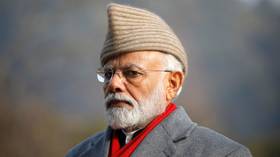How Modi shifted the India-Pakistan paradigm

The sharp escalation of tensions and clashes between India and Pakistan in recent weeks symbolizes a new phase in an old confrontation that dates back to the bitter partition of the two countries in 1947 on religious lines.
The two South Asian rivals have fought three wars and one quasi-war over the last seven decades, besides engaging in periodic shorter clashes over their disputed border and sparring in international diplomatic arenas.
While it is hard to find any extended spell of normalcy in bilateral relations, the conflict had settled into a low-intensity pattern for years. Short of full-scale wars since 1971, the focus was on how India could respond to Pakistan's doctrine of 'bleeding India through a thousand cuts' through lethal Islamist terrorists that were trained, financed and let loose by the military dictatorship of General Zia-ul-Haq in the 1980s.
The unconventional threat posed by Pakistan-harboured jihadist terrorist outfits like Lashkar-e-Taiba and Jaish-e-Muhammad, which boasted thousands of holy warriors in their ranks ready to strike India and force it to concede Kashmir's accession to Pakistan, posed a conundrum to New Delhi. These terrorist proxies would infiltrate fighters into India through the mountainous Himalayan border or radicalize Indian Muslims to carry out deadly attacks on Indian civilians and Indian military personnel.
Also on rt.com De-escalation delayed: India & Pakistan exchange shelling on Kashmir border, casualties reportedSince these jihadists were 'irregulars' and not official Pakistani security forces, India fought back mainly through counter-insurgency and stayed within the part of Kashmir which it controlled. Essentially, it was a defensive approach based on internal security. Secondarily, India also attempted to stoke tit-for-tat separatism among Pakistan's alienated Baloch and Pashtun minorities. However, these tactics could not deter daring hits by Pakistani jihadists and their sympathizers on Indian soil, the most glaring of which were the November 2008 Mumbai attacks carried out by Lashkar.
The moniker of 'soft state' hung over India as it seemed unable to take the fight inside Pakistan and had to keep on mopping up endless waves of terrorist attacks on its home turf.
Modi, the Game Changer
Then came Narendra Modi, who stormed to power in India's 2014 general elections with a vow to push the envelope and deter the jihadist threat from Pakistan through forceful means. Unlike his predecessors, the Indian prime minister wore nationalism on his sleeve and had the propensity to take calculated risks for national security. In September 2016, following a jihadist attack by Lashkar on an Indian military camp in Uri in Indian-administered Kashmir, Modi ordered 25 commandos of the Indian Army to cross over the Line of Control (LoC) into Pakistan-administered Kashmir.
Through stealth and surprise, the intruders went three kilometers inside Pakistani territory and destroyed seven terrorist camps, killing approximately 50 jihadists, and then slipped back into India. Pakistan denied that these 'surgical strikes' had any impact and downplayed the whole episode as an Indian 'illusion'. Admitting these strikes would amount to Islamabad acknowledging the presence of jihadists on its soil and also conceding a major military failure. The scale of these operations was unprecedented in peacetime and conveyed a message from India that it had a bold political leadership willing to take the battle into the adversary's zone.
While the 2016 surgical strikes did not deter Pakistan-sponsored jihadist extremism against India, it signaled that Modi would go further than previous Indian prime ministers with the motto of 'counterattack is the best defence', while limiting the targets of Indian retaliation to the 'irregular' jihadis and their infrastructure rather than engaging Pakistan's formal military and its installations in frontal combat.
What happened on February 26, 2019, was essentially 'surgical strikes 2.0', but using a different modus operandi. Following the worst suicide bombing in Indian-administered Kashmir in Pulwama, which killed 40 Indian troops, and intelligence reports of more imminent jihadist attacks in India, Modi authorized the Indian Air Force (IAF) to fly a large formation of fighter jets in the dark of the night more than 30 kilometers inside Pakistan and strike Jaish training camps.
India claimed to have blown to smithereens a major jihadist base in Balakot, which is in Pakistan proper and beyond Pakistani-administered Kashmir, and killed hundreds of terrorists. Once again, Pakistan ridiculed Indian claims of success and put on a brave face that there were no terrorists in Balakot and that Indian aircraft only dropped bombs on uninhabited land. What Pakistan could not deny was that Indian fighter jets penetrated quite far inside Pakistani airspace, evading Pakistan's air defense systems, and went back unscathed into Indian airspace.
It was the first ever use of Indian air power across the LoC since the 1971 war. A retired Air Vice Marshal of the IAF, Arjun Subramaniam, argued that these attacks marked a strategic milestone where Modi overcame decades of political hesitation and opted to use air power "as an effective tool of deterrence in sub-conventional operations." The IAF had been offering Indian civilian leaders the option of aerial bombing of terrorist launch pads inside Pakistan since the 1990s, but only Modi dared to activate it and thereby crossed a Rubicon.
Although Pakistan has criticized Modi as a war-monger and a hawk who was trying to ratchet up tensions with it and milk the resulting nationalism in India for winning the upcoming general elections there, these 'surgical strikes 2.0' were inevitable if one understands the evolution of Modi's national security thought and the compulsions he was facing as a result of growing jihadist activities across the LoC.
Even if there were no elections on the horizon in India and something on the scale of the Pulwama suicide bombing and other planned attacks were to occur, Modi would have reacted exactly as he did to raise the costs of Pakistan's proxy warfare. In the words of a retired Indian Army General, A.K.Singh, Modi is not escalating the war matrix but escalating the 'signaling matrix' to Pakistan that "we have political will, we have the resolve and we have the capabilities to come and inflict punishment."
Controlled Aggression and Deterrence
The IAF attacks in Pakistan-controlled Balakot, Muzaffarabad and Chakoti led to Pakistan's own retaliatory Air Force raids across the LoC which led to the loss of a Russian-made Indian MiG-21 plane and an American-made Pakistani F-16 jet (Islamabad has not accepted that it lost any aircraft in the dogfights). The spectacle of an IAF pilot captured by Pakistan on its soil and his subsequent return to India after international pressure on Pakistan from the US, Saudi Arabia, and the UAE grabbed global headlines.
Also on rt.com Pakistan hands over captured air force pilot to IndiaThe international community, especially the Saudi Crown Prince Mohammad bin Salman, played a key intermediary role behind the scenes to resolve the row over the captive IAF pilot, suggesting that Modi had also made diplomatic inroads into Pakistan's traditional Islamic support system in the Persian Gulf region. He has courted the friendship and investments of Saudi Arabia, Qatar, Kuwait, and the UAE and weakened Pakistan's sway in the Organisation of Islamic Cooperation (OIC) group of Muslim-majority countries. He is also using broad sympathy in the UN Security Council to apply diplomatic pressure and isolate Pakistan.
But the bigger story which will have lasting strategic implications is that Modi has the gumption to use the conventional might of India to undertake controlled offensives against Pakistan that fall short of war. India called the surgical strikes 2.0 'non-military pre-emptive action', a phrase that clearly indicates more such countermeasures are on the anvil through land, air or sea if and when there are terrorist attacks or plots being hatched by Pakistan-based jihadists against India.
Conflict Below the Threshold
Many in the international community have sided with India's right to defend itself against terrorism, but the world is also anxious to avert full-scale India-Pakistan war. Given India's far bigger and dynamic economy which can sustain a long war, India's overwhelming conventional military superiority over Pakistan (New Delhi has three to five times larger forces and weapons inventories than Islamabad), and the fact that both countries are assured of mutual destruction if they resort to their nuclear arsenals, this conflict is unlikely to spiral into the worst-case scenario of total war.
Pakistan was the first mover into the sub-conventional warfare domain after it sustained a big loss in the 1971 war with India. Now, Modi has come up with his own sub-conventional doctrine of pre-emption that is precise, disciplined and proportionate. India is not Israel and never can be that aggressive in countering terrorism because it has ambitions of being accepted internationally as a responsible nation that would one day become a great power. Moreover, India has to contend with the much more formidable challenge that it faces from China on its other border and the tight-knit China-Pakistan 'all weather alliance'.
Also on rt.com Kashmir crisis: Tempers run high, but India & Pakistan will avoid all-out war – analystsWhether Modi will succeed in establishing a new 'balance of terror' and ending the jihadist threat once and for all remains to be seen. But the Indian Prime Minister has dragged South Asia into a different paradigm and it may counter-intuitively pave the way to much-needed stability and security in the region.
Think your friends would be interested? Share this story!
The statements, views and opinions expressed in this column are solely those of the author and do not necessarily represent those of RT.














